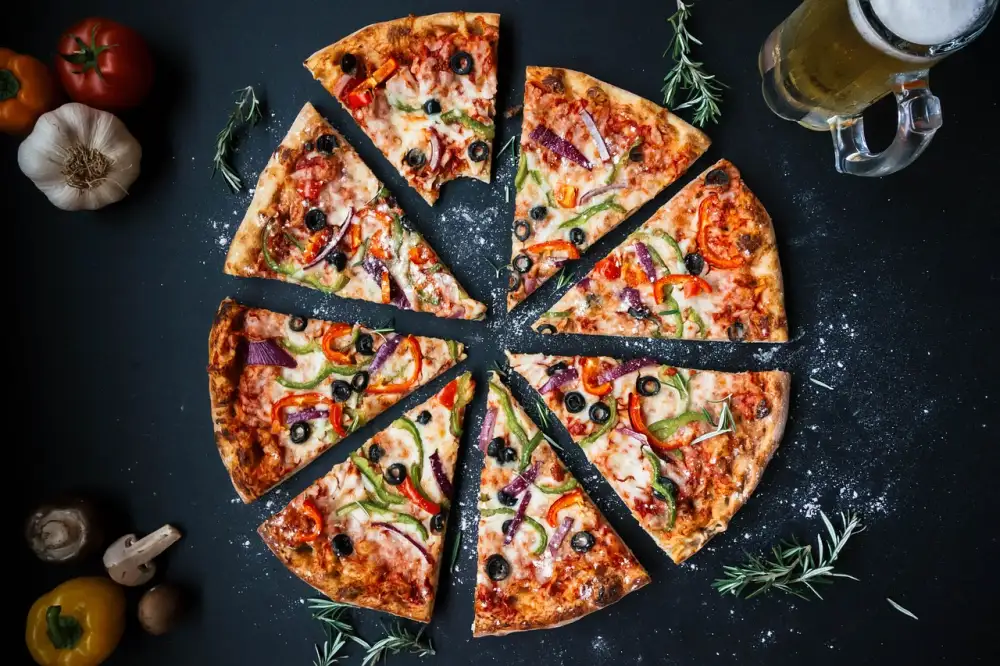Deliciously Crispy and Gluten-Free: Indulge in the Ultimate Pizza Recipe

- Understanding gluten and its effects on health
- Benefits of choosing gluten-free pizza
- Ingredients for making gluten-free pizza dough
- Step-by-step instructions for preparing gluten-free pizza dough
- Tips for achieving a perfect gluten-free pizza crust
- Toppings and sauce options for gluten-free pizza
- Baking and serving gluten-free pizza
- Variations and creative ideas for gluten-free pizza
Pizza is a beloved dish enjoyed by people all over the world. However, for those with gluten sensitivities or celiac disease, indulging in this culinary delight can be challenging. That's where gluten-free pizza comes in. This delicious alternative allows everyone to savor the flavors of a crispy and satisfying pizza crust without the worry of adverse health effects. Whether you have dietary restrictions or simply want to explore new culinary horizons, gluten-free pizza offers a delectable solution that will leave you craving for more. Let's dive into the world of gluten-free pizza and discover how you can indulge in the ultimate pizza experience while staying true to your dietary needs.
Understanding gluten and its effects on health
Understanding Gluten and Its Effects on Health
Gluten is a protein found in wheat, barley, and rye. While it may not cause any harm to most people, there are individuals who have gluten intolerance or celiac disease. For them, consuming gluten can lead to digestive issues, nutrient deficiencies, and even damage to the small intestine.
Celiac disease is an autoimmune disorder where the immune system mistakenly attacks the lining of the small intestine when gluten is consumed. This can result in symptoms like abdominal pain, bloating, diarrhea, and fatigue. Long-term effects of untreated celiac disease include malnutrition and an increased risk of other autoimmune disorders.
Even for those without celiac disease or gluten intolerance, reducing gluten intake has gained popularity due to its potential health benefits. Some studies suggest that a gluten-free diet may improve digestion, reduce inflammation in the body, and alleviate symptoms of certain conditions like irritable bowel syndrome (IBS).
By choosing gluten-free pizza, individuals with gluten sensitivity or celiac disease can enjoy this beloved dish without worrying about adverse health effects. It allows them to indulge in the flavors they love while still taking care of their well-being.
Benefits of choosing gluten-free pizza
Choosing gluten-free pizza comes with a multitude of benefits. Firstly, it caters to individuals with gluten sensitivities or celiac disease, allowing them to enjoy the pleasure of pizza without any adverse reactions. Secondly, a gluten-free diet has been linked to improved digestion and increased energy levels. By opting for gluten-free pizza, you are making a conscious choice to prioritize your health and well-being. Additionally, gluten-free pizza often incorporates alternative flours such as almond or rice flour, which can add unique flavors and textures to the crust. Lastly, by embracing gluten-free options, you are expanding your culinary horizons and discovering new and exciting flavors that can enhance your overall dining experience. So why not indulge in the deliciousness of gluten-free pizza while reaping all these wonderful benefits?
Ingredients for making gluten-free pizza dough
To make a delicious gluten-free pizza dough, you will need the following ingredients:
1. Gluten-free flour blend: Look for a pre-made blend that includes a mix of flours like rice flour, tapioca flour, and potato starch. This combination will give your dough the right texture and flavor.
2. Xanthan gum: This ingredient helps bind the dough together since gluten is absent. It acts as a substitute for the elasticity that gluten provides.
3. Yeast: Use active dry yeast to help the dough rise and create a light and airy crust.
4. Warm water: The temperature of the water is crucial for activating the yeast. Make sure it's warm but not too hot to avoid killing the yeast.
5. Olive oil: Adding olive oil to the dough will enhance its flavor and make it easier to work with.
6. Salt: A pinch of salt will enhance the taste of your pizza dough.
7. Sugar or honey: These sweeteners help feed the yeast, allowing it to ferment and create bubbles in the dough.
By using these ingredients, you can create a gluten-free pizza dough that is just as delicious and satisfying as traditional pizza crusts.
Step-by-step instructions for preparing gluten-free pizza dough
Preparing gluten-free pizza dough is easier than you might think. Follow these simple steps to create a delicious and crispy crust:
1. In a large mixing bowl, combine 2 cups of gluten-free flour blend, 1 teaspoon of xanthan gum, 1 teaspoon of salt, and 1 tablespoon of instant yeast.
2. In a separate bowl, whisk together 1 cup of warm water and 2 tablespoons of olive oil.
3. Slowly pour the wet ingredients into the dry ingredients while stirring with a wooden spoon or spatula.
4. Continue to mix until a sticky dough forms. If the dough seems too dry, add more warm water, one tablespoon at a time.
5. Once the dough comes together, transfer it onto a lightly floured surface and knead for about 5 minutes until smooth and elastic.
6. Shape the dough into a ball and place it back into the mixing bowl. Cover with a clean kitchen towel and let it rise in a warm place for about an hour or until doubled in size.
7. Preheat your oven to 450°F (230°C) and place a pizza stone or baking sheet inside to heat up.
8. Once the dough has risen, divide it into two equal portions for thin crust pizzas or leave it as one for thicker crusts.
9. Roll out each portion on parchment paper using a rolling pin until you achieve your desired thickness.
10. Transfer the rolled-out dough onto the preheated pizza stone or baking sheet and bake for about 8-10 minutes until golden brown.
Now that you have mastered making gluten-free pizza dough, it's time to move on to choosing your favorite toppings and sauces!
Tips for achieving a perfect gluten-free pizza crust
1. Use a combination of gluten-free flours: Experiment with different combinations of gluten-free flours like rice flour, almond flour, tapioca flour, or chickpea flour to achieve the right texture and flavor.
2. Add xanthan gum or psyllium husk powder: These ingredients help bind the dough together and give it elasticity, making it easier to handle and preventing it from crumbling.
3. Let the dough rest: Allow the dough to rest for at least 30 minutes before rolling it out. This helps the flours absorb moisture and gives the crust a better texture.
4. Roll out the dough between two sheets of parchment paper: Gluten-free dough can be sticky, so rolling it out between parchment paper prevents it from sticking to your rolling pin or countertop.
5. Pre-bake the crust: To ensure a crispy crust, pre-bake it for a few minutes before adding toppings. This helps prevent sogginess and ensures that the toppings don't weigh down the crust.
6. Brush olive oil on the crust: After pre-baking, brush olive oil on the crust to add flavor and create a barrier that prevents moisture from seeping into the crust.
7. Use a pizza stone or baking steel: For an extra crispy crust, place your pizza on a preheated pizza stone or baking steel in the oven. This helps distribute heat evenly and gives you that perfect crunch.
8. Don't overload with toppings: Avoid piling too many toppings on your gluten-free pizza as they can make the crust soggy. Stick to lighter toppings like fresh vegetables, herbs, and cheeses.
By following these tips, you can achieve a deliciously crispy gluten-free pizza crust that rivals its traditional counterpart!
Toppings and sauce options for gluten-free pizza
When it comes to toppings and sauce options for gluten-free pizza, the possibilities are endless. You can stick with traditional favorites like tomato sauce and mozzarella cheese or get creative with unique combinations. For a classic Margherita pizza, top your gluten-free crust with fresh basil leaves, sliced tomatoes, and buffalo mozzarella. If you're in the mood for something more adventurous, try a BBQ chicken pizza with tangy barbecue sauce, grilled chicken, red onions, and cilantro. Other delicious options include pesto sauce with roasted vegetables, prosciutto and arugula with a drizzle of balsamic glaze, or even a white sauce pizza with garlic, ricotta cheese, spinach, and mushrooms. Don't be afraid to experiment and find your own favorite flavor combinations. The key is to use high-quality ingredients that will enhance the flavors of your gluten-free crust.
Baking and serving gluten-free pizza
Baking and serving gluten-free pizza is just as important as preparing the dough and choosing the toppings. To ensure a crispy crust, preheat your oven to a high temperature, around 475°F (245°C). Place a pizza stone or baking sheet in the oven while it preheats to help achieve an even heat distribution.
Once the oven is hot, carefully transfer your prepared pizza onto the preheated stone or baking sheet. Bake for about 12-15 minutes, or until the crust turns golden brown and crispy. Keep an eye on it to avoid overcooking.
When it's done, remove the pizza from the oven and let it cool for a few minutes before slicing. This will allow the flavors to settle and prevent any toppings from sliding off.
Serve your gluten-free pizza with a side of fresh salad or enjoy it on its own. The beauty of homemade gluten-free pizza lies in its versatility - you can customize it according to your preferences, dietary restrictions, and creativity.
Remember to savor every bite of this delicious creation without worrying about any gluten-related health issues. Gluten-free pizza allows everyone to indulge in this beloved comfort food without compromising their well-being. So go ahead, dive into this ultimate culinary delight and relish every mouthwatering moment!
Variations and creative ideas for gluten-free pizza
Variations and creative ideas for gluten-free pizza are endless, allowing you to explore different flavors and textures. Here are a few ideas to inspire your culinary creativity:
1. Margherita Twist: Top your gluten-free pizza crust with fresh mozzarella, sliced tomatoes, basil leaves, and a drizzle of balsamic glaze for a classic yet refreshing twist.
2. Mediterranean Delight: Spread hummus as the base sauce and add toppings like roasted red peppers, kalamata olives, feta cheese, and a sprinkle of oregano for a taste of the Mediterranean.
3. BBQ Chicken Bliss: Smother your crust with tangy barbecue sauce, cooked chicken breast pieces, red onions, cilantro, and a blend of cheddar and mozzarella cheeses for a smoky and savory treat.
4. Veggie Extravaganza: Load up your pizza with an assortment of colorful vegetables such as bell peppers, mushrooms, spinach, cherry tomatoes, and artichoke hearts for a healthy and vibrant option.
5. Pesto Paradise: Swap out traditional tomato sauce with pesto as the base and top it off with grilled chicken strips, sun-dried tomatoes, pine nuts, and Parmesan cheese for a burst of herbaceous flavors.
Remember to experiment with different combinations of ingredients to find your favorite flavor profiles. The beauty of gluten-free pizza is that it can be customized to suit any dietary preference or taste preference. Let your imagination run wild as you create delicious masterpieces in every bite!
In conclusion, indulging in the deliciousness of gluten-free pizza is a treat for both your taste buds and your health. With the right ingredients and techniques, you can create a crispy and flavorful pizza crust that is free from gluten. Whether you have dietary restrictions or simply want to try something new, gluten-free pizza offers a tasty alternative that everyone can enjoy. So go ahead, gather your favorite toppings, experiment with different flavors, and savor every bite of this ultimate pizza recipe.
Published: 22. 12. 2023
Category: Recipes



